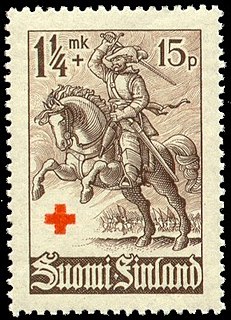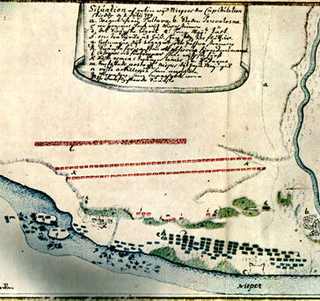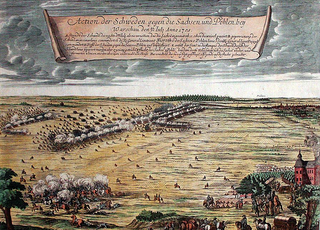
The Battle of Poltava was the decisive victory of Peter I of Russia, also known as "the Great," over the Swedish forces under Field Marshal Carl Gustav Rehnskiöld, in one of the battles of the Great Northern War.

Hakkapeliitta is a historiographical term used for a Finnish light cavalryman in the service of King Gustavus Adolphus of Sweden during the Thirty Years' War. Hakkapeliitta is a 19th-century Finnish modification of a contemporary name given by foreigners in the Holy Roman Empire and variously spelled as Hackapelit, Hackapelite, Hackapell, Haccapelit, or Haccapelite. These terms were based on a Finnish battle cry hakkaa päälle, commonly translated as "Cut them down!"

Caroleans were soldiers of the Swedish Kings Charles XI and Charles XII. The tactics of Caroleans differed from those Western European soldiers in their greater reliance upon pikes, rapiers, bayonets, and offensive strategy, which led to victory in many battles even when greatly outnumbered. In order to compensate for its lack of manpower and resources, Sweden strove for innovative ways to make a more effective army. The Carolean army is regarded as one of the most effective military forces of their time for their achievements during the Great Northern War, as shown by their efforts in many important Swedish battles.

The Battle of Holowczyn or Holofzin or Golovchin was fought between the Russian forces, and the Swedish army, led by Charles XII of Sweden, only 26 years of age at the time. Despite difficult natural obstacles and superior enemy artillery, the Swedes were able to achieve surprise and defeat the numerically superior Russian forces, who were separated from each other, had no overall command and could not coordinate their actions, so that only 8,000-9,000 of them could take part in the fighting. Reportedly, it was Charles' favourite victory.

Adam Ludwig Lewenhaupt was a Swedish general.
Wolmar Anton von Schlippenbach (1653–1721) was Governor General of Swedish Estonia from 1704 to 1706.

Count Carl Gustav Rehnskiöld was a Swedish Field Marshal (Fältmarskalk) and Royal Councilor. He was King Charles XII's mentor and chief military advisor, and served as deputy commander-in-chief of the Carolean Army, an army he assisted both in its education and development.

The Battle of Gemauerthof was a battle in the Great Northern War, fought south of Riga, in present-day Latvia in July 1705. The Swedish forces under Adam Ludwig Lewenhaupt fought a Russian army under Boris Sheremetyev. The Swedes, exhausted after forced marching, went to camp and were cooking supper when the news came of a large Russian army with 16 artillery pieces nearby. The Swedes, who themselves had 17 artillery pieces quickly deployed into battle formation and, encouraged by General Lewenhaupt, attacked the Russians. Although suffering severe setbacks on their right flank, the assault continued. On the left, the Swedish cavalry charged and broke the Russians. The infantry in the centre fired carefully at point-blank range and then charged, pushing their foes back in disorder. The battle ended in a confused melee, which was eventually won by the Swedes. The Russian cavalry withdrew while the infantry was destroyed by a combined-arms assault leaving 5,000 men dead, wounded or captured. The Swedes were victorious, but the victory was only symbolic. In August, the Russians conquered Courland.

The Battle of Żarnów was fought on September 16, 1655, between the forces of the Polish-Lithuanian Commonwealth, commanded by John II Casimir and the forces of the Swedish Empire, commanded by Charles X Gustav. The result ended with a Swedish victory.

The Battle of Lübeck took place on 6 November 1806 in Lübeck, Germany between soldiers of the Kingdom of Prussia led by Gebhard Leberecht von Blücher, who were retreating from defeat at the Battle of Jena–Auerstedt, and troops of the First French Empire under Marshals Murat, Bernadotte, and Soult, who were pursuing them. In this War of the Fourth Coalition action, the French inflicted a severe defeat on the Prussians, driving them from the neutral city. Lübeck is an old Baltic Sea port approximately 50 kilometres (31 mi) northeast of Hamburg.

The surrender at Perevolochna was the capitulation of almost the entire Swedish army on June 30, 1709 (O.S.) / July 1, 1709 / July 11, 1709 (N.S.). It signified the annihilation of the once formidable Swedish army after the defeat at Battle of Poltava, and paved the way for the eventual Russian victory in the Great Northern War. After the Battle of Poltava, Charles XII escaped to Moldavia, a vassal state of the Ottoman Empire.
The Battle of Kokenhausen was a major battle opening the Polish–Swedish War (1600–1611). It took place on the 13 June (O.S.) or 23 June (N.S.) 1601 near Koknese in Livonia. In the battle, Polish forces defeated the Swedish relief force and captured the besieging force, relieving the Polish garrison. The battle is notable as one of the greatest victories of the Polish hussars, who defeated their numerically superior Swedish adversaries.

Carl Henrik Wrangel, friherre Wrangel af Adinal was an officer of the Swedish Army, eventually attaining the rank of Field Marshal.

The Battle of Warsaw was fought on 31 July 1705 near Warsaw, Poland, during the Great Northern War. The battle was part of a power struggle for the Polish–Lithuanian throne. It was fought between Augustus II the Strong and Stanisław Leszczyński and their allies. Augustus II entered the Northern war as elector of Saxony and king of the Polish–Lithuanian Commonwealth, and had formed an alliance with Denmark–Norway and Russia. Stanisław Leszczyński had seized the Polish throne in 1704, with the support of the Swedish army of Charles XII of Sweden. The struggle for the throne forced the Polish nobility to pick sides; the Warsaw Confederation supported Leszczyński and Sweden, and the Sandomierz Confederation supported Augustus II and his allies. The conflict resulted in the Polish civil war of 1704–1706.

The Dano–Swedish War of 1808–1809 was a war between Denmark–Norway and Sweden due to Denmark–Norway's alliance with France and Sweden's alliance with the United Kingdom during the Napoleonic Wars. Neither Sweden nor Denmark-Norway had wanted war to begin with but once pushed into it through their respective alliances, Sweden made a bid to acquire Norway by way of invasion while Denmark-Norway made ill-fated attempts to reconquer territories lost to Sweden in the 17th century. Peace was concluded on grounds of status quo ante bellum on 10 December 1809.
The Defence Act of 2000 was a defence act passed by the Swedish Riksdag on 30 March 2000, and the largest reorganisation of the Swedish Armed Forces since the Defence Act of 1925. The act was a continuation of the policies set in motion by the Defence Act of 1996: shifting the military's focus from the defence of Swedish territory to a more flexible "operational defence* for smaller-scale peacekeeping operations in foreign nations. Many military formations were disbanded as a result.














